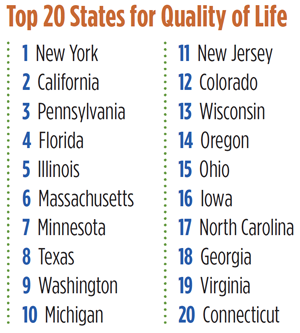Ask 10 location experts what their top quality of life ingredient is, and you’ll likely get about 10 different answers. Most would agree that housing costs and availability, education options, cultural amenities and commute times are high on their list, but it varies from person to person.
Personal finance company WalletHub released in August its 2024 Best States to Live In, which uses 51 indicators of livability to compare the 50 states. The indicators are organized into five categories, each weighted 20%. They are affordability, economy, education and health, quality of life and safety. Following is the overall rank of the Top 20 states.
The quality-of-life component — one fifth of the overall ranking — consists of 16 weighted metrics including average hours worked per week, average commute time, access to public transportation, quality of roads and the number of restaurants, bars, museums, performing arts centers, movie theaters and fitness centers per capita.
Among other questions WalletHub asked experts from academia was this: What can state policymakers do to attract and retain new residents?
“There is a lot of talk about keeping taxes low,” said Howard Yaruss, adjunct assistant professor at New York University. “Nevertheless, for many years, some of the highest tax states, such as New York and California, were attracting residents and some of the lowest tax states, such as Mississippi and West Virginia, were losing residents. That said, taxes are clearly one factor in attracting and retaining residents, but states ignore all the other factors at their peril. These include good infrastructure, job growth, quality of life, good schools, and safe/welcoming streets and public spaces.”
 Dr. Randal Ice, professor emeritus at the University of Central Oklahoma: “Recognize that we are seeing more and more people who are geographically flexible and will choose their location based on a variety of local factors. Attracting new residents, particularly those who can advance commerce in a state, is important. Not everyone is geographically flexible, but enough are that states should always consider how laws impact the desirability of their location.
Dr. Randal Ice, professor emeritus at the University of Central Oklahoma: “Recognize that we are seeing more and more people who are geographically flexible and will choose their location based on a variety of local factors. Attracting new residents, particularly those who can advance commerce in a state, is important. Not everyone is geographically flexible, but enough are that states should always consider how laws impact the desirability of their location.
“Make sure tax rates are competitive, particularly for high-income and highly mobile individuals like retirees,” he adds. “However, even highly paid CEOs can move a company to a low-tax location, taking many jobs to a new state when tax rates are unfavorable. Life is about more than taxes, however. Quality of life factors play a role in where people want to settle. States should consider these factors when providing services to their residents and act accordingly. It is a very competitive world for the best and the brightest.”

